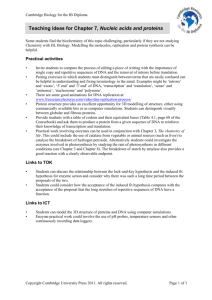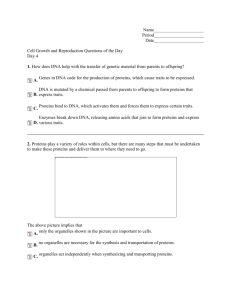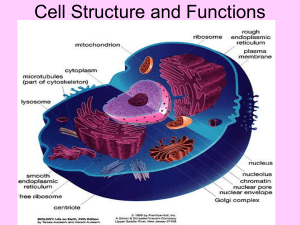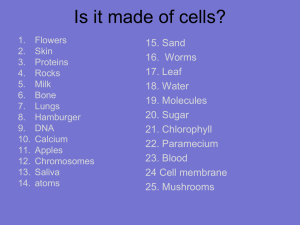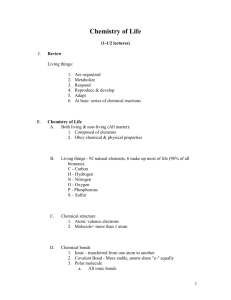Spotlight More About This Article
advertisement
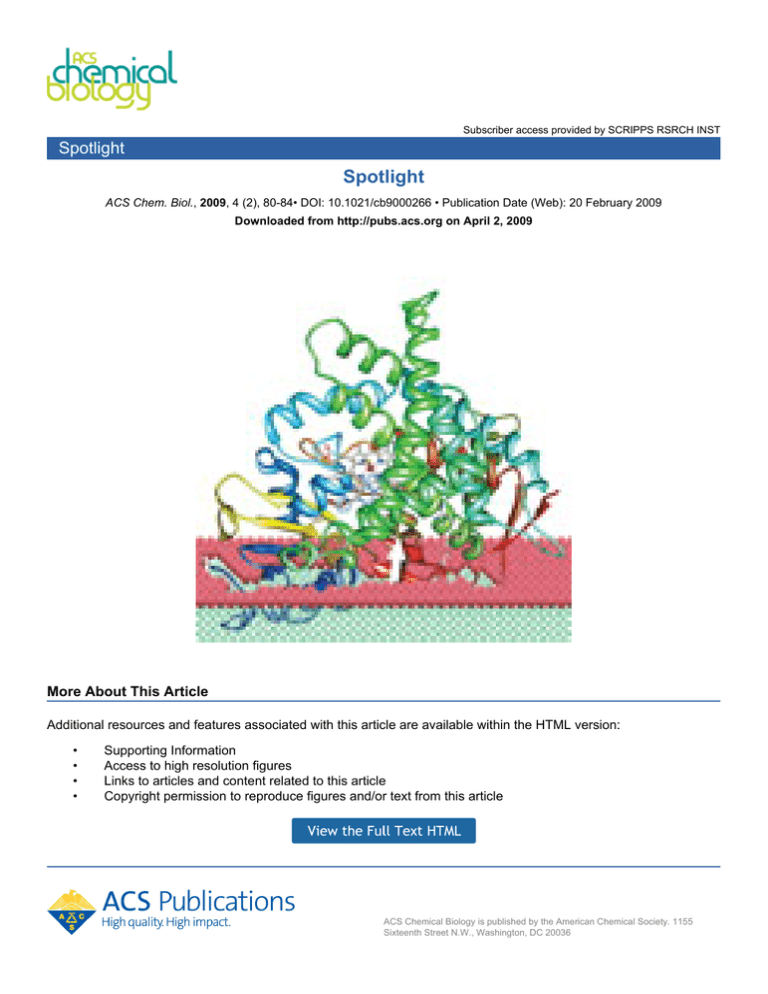
Subscriber access provided by SCRIPPS RSRCH INST Spotlight Spotlight ACS Chem. Biol., 2009, 4 (2), 80-84• DOI: 10.1021/cb9000266 • Publication Date (Web): 20 February 2009 Downloaded from http://pubs.acs.org on April 2, 2009 More About This Article Additional resources and features associated with this article are available within the HTML version: • • • • Supporting Information Access to high resolution figures Links to articles and content related to this article Copyright permission to reproduce figures and/or text from this article ACS Chemical Biology is published by the American Chemical Society. 1155 Sixteenth Street N.W., Washington, DC 20036 The Difference Between Male and Female? The differences between men and women may be too many to count, but at the molecular level, a single enzyme is responsible for converting androgens, the characteristic male sex hormones, to their female counterparts, estrogens. Aromatase, which resides as a membrane-bound protein in the endoplasmic reticulum (ER), is a cytochrome P450 that is responsible for hydroxylating and aromatizing androgens such as testosterone to estrogens like 17-estradiol. Given the pivotal, detrimental role that estrogen plays in certain breast cancers, development of aromatase inhibitors is a promising anticancer strategy. However, despite many years of study, the structure of the enzyme and the mechanism of the aromatization step have remained elusive. Ghosh et al. (Nature 2009, 457, 219⫺224) now report the crystal structure of aromatase in complex with one of its natural substrates, androstenedione. The structure revealed that aromatase retains the typical cytochrome P450 fold but also exhibits several androgen-specific characteristics. A cleft precisely complementary in shape to the steroid backbone, supported by a slew of hydrophobic, van der Waals, and hydrogen-bond interactions, gives rise to the high selectivity of aromatase for its androgen substrates. In addition to pointing to residues critical for the hydroxylation steps, the structure also offers alluring clues regarding the mechanism of aromatization. Based on the locations of three key residues, a threonine, an alanine, and an aspartate, along with the help of a water molecule and a heme group, a mechanism involving hydrogen abstraction and enolization en route to aromatization was proposed. The locations of certain hydrophobic helices and key residues indicative of lipid integration suggested the manner in which aromatase is integrated into the ER membrane, providing a rationale for how its lipophilic substrates gain access to its active site. These exquisite details of aromatase structure and function will no doubt facilitate design of more sophisticated aromatase inhibitors in the future. Eva J. Gordon, Ph.D. Reprinted by permission from Macmillan Publishers Ltd.: Nature, Ghosh, D., et al., 457, 219ⴚ224, copyright 2009. A Radical Phosphorylation Detection Approach The development of mass spectrometry (MS) methods for protein characterization has transformed our ability to explore cellular processes. For example, application of these methods to identify sites of protein phosphorylation has greatly facilitated characterization of cellular signaling events. Ironically, the chemical characteristics that enhance the isolation of phosphopeptides, which are transient by nature, can actually hinder the MS-based identification process. Now, Swaney et al. (Proc. Natl. Acad. Sci. U.S.A. 2009, 106, 995⫺1000) report the use of the recently developed MS method electron transfer dissociation (ETD), in combination with the standard method of collision-activated dissociation (CAD), to characterize the phosphoproteome of human embryonic stem (ES) cells. In CAD, selected peptide cations are collided with rare-gas atoms, and this leads to the cleavage of amide bonds. In phosphorylated peptides, however, this collision can often result in cleavage of the phosphoryl group. In ETD, cleavage of the amide bond pro- Swaney, D. L., et al., Proc. Natl. Acad. Sci. U.S.A., 106, 995ⴚ1000. Copyright 2009 National Academy of Sciences, U.S.A. ceeds via radical chemistry, which leaves phosphoryl groups untouched. Proteins isolated from human ES cells were subjected to Published online February 20, 2009 • 10.1021/cb9000266 CCC: $40.75 © 2009 American Chemical Society 80 ACS CHEMICAL BIOLOGY • VOL.4 NO.2 www.acschemicalbiology.org MS/MS analysis by either CAD or ETD, and the results were combined and analyzed for several features, such as the number of unique phosphopeptides, the number of phosphorylation sites, and the number of total proteins identified. The analyses revealed that, for examination of protein phosphorylation, ETD was superior to CAD in several aspects, including fragmentation efficiency, sequence coverage, phosphorylation site localization, and peptide identification. However, CAD was superior in other aspects, for example, in identifying phosphopeptides of low net charge. Thus, to ensure that the most comprehensive view is obtained, proteomic characterizations seem best served by using both CAD and ETD. Notably, characterization of the ES cell phosphoproteome by CAD and ETD led to the identification of previously unknown phosphorylation sites on transcription factors known to regulate pluripotency (the ability of ES cells to differentiate into all cell types). This and further characterizations of the ES cell phosphoproteome will help advance efforts in stem cell research for a variety of therapeutic applications. Eva J. Gordon, Ph.D. the membrane fractions with the biotin-azide, led to the identification of several hundred predicted palmitoylated proteins. Many of the identified proteins validated this approach, since they were either known palmitoylation targets or homologues of proteins known to be palmitoylated in other organisms. In addition, however, several proteins not previously associated with palmitoylation were identified. Verification that such proteins were not a result of an artifact inherent in the profiling process was accomplished using 17ODYA and click chemistry. This time, membrane fractions of 17OYDA-labeled cells engineered to overexpress the putative palmitoylation targets were reacted with a fluorescent azide that rendered them suitable for rapid evaluation by gel electrophoresis. This analysis indicated that 90% of the proteins identified in the proteomic profiling experiments were indeed palmitoylated. In addition to providing a method for cataloging all palmitoylated proteins in a given proteome, this approach also offers insight into the features that regulate palmitoylation, such as how the number and placement of cysteine residues at the protein terminus affects the palmitoylation process. Eva J. Gordon, Ph.D. Toying with Palmitoylation Protein palmitoylation, a process in which fatty acids such as palmitic acid are attached to cysteine residues on target proteins, helps mediate protein association with membranes. Efforts to identify palmitoylated proteins and characterize the biological significance of this covalent yet reversible posttranslational modification have yielded only modest progress, in large part due to tedious protocols and high false positive rates. Now, Martin and Cravatt (Nat. Methods 2009, 6, 135⫺138) describe an efficient, reliable approach for proteomic profiling of palmitoylated proteins in mammalian cells. Probing Ammosamide Activity Marine bacteria are a rich source of natural products with diverse biological activities. Many bacterial secondary metabolites target cytoskeletal proteins, such as tubulin and Actin, which results in arrest of the cell cycle. The anticancer potential of such compounds makes the continued search for novel metabolites of great therapeutic interest. Hughes et al. (Angew. Chem., Int. Ed. 2009, 48, 728⫺732) now report that two compounds from deep sea actinomycetes, ammosamides A and B, inhibit the cell cycle through targeting of the motor protein myosin. Reprinted by permission from Macmillan Publishers Ltd.: Nature Methods, Martin and Cravatt, 6, 135ⴚ138, copyright 2009. The profiling strategy relies on the use of the palmitic acid analog 17-octadecynoic acid (17-ODYA) and click chemistry, where the alkyne moiety in 17-ODYA is exploited for a highly selective cycloaddition reaction with an azide labeled with a biotin group. Metabolic labeling of a human T-cell line with 17-ODYA, followed by reaction of www.acschemicalbiology.org Reproduced with permission from Angew. Chem., Int. Ed. from Wiley-VCH, Hughes, C. C. et al., 2009, 48, 728. Key to the success of this study was the creation of an ammosamide-derived immunoaffinity fluorescence probe. A fluorescent coumarin derivative that also possessed an epitope to a VOL.4 NO.2 • ACS CHEMICAL BIOLOGY 81 monoclonal antibody was conjugated to ammosamide B. First, the fluorescent properties of the probe were used to characterize the uptake, localization, and activity of ammosamide in live cells. Fluorescence microscopy experiments indicated that the compound is readily taken in by various cell types and localizes throughout the cytosol and in vesicles over time. FACS analysis further demonstrated that the probe inhibited cell division at various stages of the cell cycle. Next, the immunoaffinity properties of the probe were used to identify its target. Coimmunoprecipitation experiments, followed by mass spectrometry and affinity validation, revealed that the probe bound to myosin. The role of myosin in cytoskeletal structuring prompted investigation into Actin and microtubule assembly in the presence of ammosamide, and indeed, an increase in Actin filaments and prominent microtubule depolymerization were observed. Finally, histological studies revealed that the ammosamide probe stained a wide range of cell types and tissues, suggesting that it targets several of the myosin families. The versatility inherent to the design of this ammosamide probe greatly facilitated elucidation of ammosamide activity, and an extension of this approach should be useful to the study of other natural products. Eva J. Gordon, Ph.D. Early Release for Bad Behavior The central dogma of information flow from DNA to RNA to proteins is conserved from bacteria to the mammals, but often lost in this simplistic view are the taskmaster activities that keep the flow in check. The fidelity of events like DNA replication, RNA transcription, and protein translation must proceed with near perfection to stop deleterious mutation or poisonous proteins from mucking up the fate of the cell. While DNA polymerases can make mistakes during catalysis but can also move back one nucleotide to try again, the translational machinery has long been viewed as a gatekeeper for fidelity prior to peptide bond formation. The enzymes that put amino acids onto the cognate tRNAs, the aminoacyl-tRNA synthetases, show exquisite specificity. In addition, the ribosome and its accessory proteins are also very particular during decoding. Now, an impressive study in a purified bacterial translation system shows that the ribosome carries out an unknown fidelity check after peptidyl transferase chemistry. With a rigorous biochemical approach, Zaher and Green (Nature, 2009, 457, 161⫺166) found that following a single miscoding error ribosomes become much more error-prone, leading to aberrant translation and ultimately to premature termination of the process. What this means in biochemical terms is that release factors, normally reserved for recognizing an mRNA stop codon in the ribosome with great precision, now recognize essentially any codon for releasing the growing peptide product. Thus, this quality control activity of peptide release after peptide bond formation competes with the normal elongation activity and the miscoding tRNA-peptide appears 82 ACS CHEMICAL BIOLOGY • VOL.4 NO.2 Reprinted by permission from Macmillan Publishers Ltd.: Nature, Zaher and Green, 457, 161ⴚ166, copyright 2009. to control this balance. Unlike DNA polymerase, which can fix its errors, the ribosome simply discards peptides with errors and begins anew. With high resolution structures of the ribosome in hand, the next challenge will be to understand how these miscoding events in the P site of the ribosome communicate with the release factor binding in the A site. Jason G. Underwood, Ph.D. A Bitter Pill for Plant Pathogens In addition to causing the bitter flavor in foods such as mustard, horseradish, and Brussels sprouts, glucosinolates can also be a bitter pill to swallow for certain plant predators. Glucosinolates, which are composed of a thioglucoside linked via a carbon atom to a sulfated nitrogen moiety, are plant secondary metabolites that play an important role in deterring insects. Recent evidence also suggests that glucosinolate metabolism is induced upon plant exposure to certain microbial pathogens. However, the pathways involved in this response have remained elusive. Now, two reports (Clay et al. (Science 2009, 323, 95⫺101) and Bednarek et al. (Science 2009, 323, 101⫺106)) uncover details of a novel glucosinolate metabolic pathway in the small flowering plant Arabidopsis and elucidate key aspects of its role in the plant innate immune response. Bednarek et al. begin by investigating the molecular basis for antifungal defense by Arabidopsis. Wild-type strains and strains defective in PEN2 (a protein thought to function as a glycosyl hydrolase and known to be involved in plant defense pathways) were exposed to the powdery mildew fungus Blumeria graminis. Metabolic profiling experiments performed on leaf extracts, followed by structural analysis, indicated that several indole glucosinolate-related metabolites were involved in the plant response to the fungus. It was also determined that the cytochrome P450 CYP81F2 monooxygenase is involved in production of the indole glucosinolate 4-methoxy-I3G, www.acschemicalbiology.org ning to be uncovered. Further exploration of this intriguing pathway will help unravel the many complex pathways involved in plant defense. Eva J. Gordon, Ph.D. An Amphiphilic Approach From Bednarek, P., et al., Science, 2009, 323, 101. Reprinted with permission from AAAS. which then appears to serve as a substrate for PEN2 activity as a myrosinase, an enzyme that hydrolyzes glucosinolates. This finding was unexpected on the basis of the predicted catalytic residues of PEN2. Notably, the metabolism of glucosinolates initiated by PEN2 produces compounds different from those triggered by damage from chewing insects, indicating that separate glucosinolate metabolic pathways exist depending on the specific immune response induced in the plant. In a related study, Clay et al. employed a phenotypic assay to search for genes involved in a classic innate immune response by plants to bacteria, that of the deposition of callose, a glucan polymer, upon exposure to Flg22, a synthetic peptide derived from bacterial flagellin. Several genes involved in defense signaling by the hormone ethylene and in the biosynthesis and breakdown of glucosinolates were identified as necessary for the Flg22-induced callose response. Notably, evidence suggested that a hydrolytic product of the glucosinolate 4-methoxy-I3G, but not the glucosinolate itself, acts as a signaling molecule for callose deposition. Further transcriptional and metabolic profiling studies of Arabidopsis mutants revealed that the myrosinase PEN2, along with the genes encoding the phytochelatin synthase PCS1 and the ABC transporter PEN3, are responsible for hydrolysis and other breakdown reactions of the glucosinolates produced upon Flg22 exposure. Moreover, the glucosinolate biosynthetic pathway was found to be regulated by feedback inhibition upon accumulation of both the glucosinolates and their hydrolysis products. Taken together, the results demonstrated that in addition to the previously defined role of glucosinolates in discouraging hungry insects, these compounds play an important role in plant defense against bacterial pathogens. These two studies offer enlightening insight into the intricate pathways of plant defense. Glucosinolates, long studied for their properties as insect deterrents, are now exposed as key compounds in the innate immune response of plants against a wide range of microbial pathogens. With the help of transcriptional and metabolic profiling methods, the signaling pathways that govern this response, as well as the key genes and proteins involved, are beginwww.acschemicalbiology.org The inherited genetic disease cystic fibrosis is characterized by the accumulation of thick mucus that is easily infected by opportunistic bacteria such as Pseudomonas aeruginosa. Unfortunately, antibiotics used to treat these infections, such as the cationic aminoglycoside tobramycin, must navigate their way through a virtual jungle of anionic polyelectrolytes, like mucin, and the protein F-Actin and DNA that are expelled from lysed inflammatory and bacterial cells, en route to their target bacteria. It is believed that, as a result of charge attractions, the presence of such anionic polyelectrolytes dramatically reduces the availability and effectiveness of the cationic antibiotics. Methods to sequester such anionic macromolecules could have promising therapeutic value, and to this end, Purdy Drew et al. (J. Am. Chem. Soc. 2009, 131, 486⫺493) report the development of cationic binding agents that effectively outcompete tobramycin binding to DNA. Reprinted with permission from Purdy Drew, K. R., et al., J. Am. Chem. Soc., 131, 486ⴚ493. Copyright 2009 American Chemical Society. Attempts to design a cationic binding agent capable of displacing tobramycin from DNA began with high-resolution synchrotron X-ray diffraction and confocal microscopy experiments, which enabled characterization of the macromolecular structure. The charge density and curvature of the DNA complex then guided the creation of an amphiphilic mixture that could successfully compete with tobramycin for DNA binding. The amphiphilic mixture was composed of a neutral lipid possessing matching negative curvature with DNA and a cationic lipid with similar charge density as DNA. Optimization of this mixture in solutions of DNA and tobramycin established its efficacy in displacing DNA-bound tobramycin and effectively sequestering DNA. In addition, P. aeruginosa growth inhibition assays demonstrated that tobramycin activity in the presence of DNA is significantly enhanced when such cationic amphiphiles are also present. These results point to a promising strategy to more effectively combat the infections so prevalent in cystic fibrosis patients. Eva J. Gordon, Ph.D. VOL.4 NO.2 • ACS CHEMICAL BIOLOGY 83 A Biochemical Sales PICh The chromatin-immunoprecipitation (ChIP) assay has revolutionized the study of gene regulation by allowing a glimpse at the binding profile of one protein within the cell nucleus. In a typical protocol, proteins are cross-linked to DNA within the native chromatin landscape, the DNA is sheared into fragments, and specific DNA fragments are affinity purified from the complex mixture with an antibody for the protein of interest. This is followed up by one of several sensitive detection methods. Now, a new technique (Cell 2009, 136, 175⫺186) starts with the same cross-linking and shearing steps but then asks for a different outcome. Instead of asking for a particular protein’s DNA partners, Déjardin and Kingston flipped the ChIP scheme around to ask what proteins are associated with a particular region of genomic DNA. The technique, known as PICh, for proteomics of isolated chromatin segments, combined the sheared chromatin and a specific biotinylated oligonucleotide to fish out a specific sequence motif from the complex mixture by hybridization. After working out the proper conditions, they then used PICh to determine all of the proteins natively associated with those genomic regions by reversing the crosslinks followed by mass spectrometric analysis. As a proof of principle, the authors went after an abundant and well studied sequence within the human genome, telomeres, which are repeated DNA elements which caps the end of every cellular chromosome. The result was an impressive list of 33 proteins previously shown to associate with telomeres and dozens of new candidates for telomere-associated factors. In situ confirmations of a subset with antibodies or overexpressed candidate proteins showed that most are bona fide telomere-associated proteins. The authors went on to compare the proteins associated with telomeres in a cell line lacking telomerase, a key enzyme in telomere maintenance. These ALT cells, for alternative lengthening of telomeres, use a recombinationbased method for keeping the chromosomes from wasting away upon replication. An unexpected and still poorly understood finding was that of orphan nuclear receptors at the telomere, which serves to underscore the opportunities made available by a technique like PICh. With further optimizations and scaling, perhaps a single copy locus might be an achievable target and PICh might be able to zoom in on the proteins associated with a single DNA segment. Jason G. Underwood, Ph.D. 84 ACS CHEMICAL BIOLOGY • VOL.4 NO.2 www.acschemicalbiology.org




